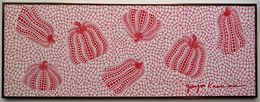
Red flower Ceramic Plate
Yayoi Kusama
Design - 22.7 x 22.7 x 1 cm Design - 8.9 x 8.9 x 0.4 inch
$5,428

Design - 22.7 x 22.7 x 1 cm Design - 8.9 x 8.9 x 0.4 inch
$5,428



Design - 78.7 x 20.3 x 1 cm Design - 31 x 8 x 0.4 inch
$2,800


Design - 2 x 26 x 20.6 cm Design - 0.8 x 10.2 x 8.1 inch
$1,392


Design - 30 x 90 x 0.1 cm Design - 11.8 x 35.4 x 0 inch
$905










Design - 15 x 25 x 25 cm Design - 5.9 x 9.8 x 9.8 inch
$406

Design - 15 x 25 x 25 cm Design - 5.9 x 9.8 x 9.8 inch
$406

Design - 30 x 90 x 0.1 cm Design - 11.8 x 35.4 x 0 inch
Sold


With just one polka dot, a painting can become a work of art.
Yayoi Kusama's monumental and immersive installations are famous worldwide! Her works have inspired artists such as Carolee Schneemann, Yoko Ono, and Damien Hirst. They have also been exhibited by the most prominent contemporary art institutions including the MoMA in New York, the Georges Pompidou Centre in Paris, and the Venice Biennale.
Born in 1929 in Nagano, Japan, Yayoi Kusama began drawing when she was a child. She started having hallucinations very early. After once having looked at a flowered tablecloth, she looked up to the ceiling and realized that she kept seeing the patterns. Kusama's hallucinations remained ever-present in her work, particularly the famous polka dots. She studied at the Kyoto School of Arts and Crafts where she trained in traditional Japanese painting (nihonga).
At the time, it was rare to see a woman evolve as an artist in patriarchal Japanese society. Her parents were against her working as an artist, especially her mother, but this only strengthened her desire to make art. She also detached herself from traditional Japanese education and granted herself more freedom by taking Western models as inspiration. At the age of 27, she moved to Seattle and later to New York, where she was forced to live with little money.
She began to exhibit her work with avant-garde artists: Yves Klein, Andy Warhol, and Jasper Johns. She collaborated with her friend Donald Judd many times, presenting increasingly provocative art.
By the 1960s, she was completely involved in the avant-garde scene. Her psychedelic art was at the forefront of the art scene, closely related to the hippie movement and to Pop Art.
Kusama produced numerous happenings (spontaneous performances that require public participation) and performances. She is also known for her "naked demonstrations" against the Vietnam War, where Kusama had often been arrested by the police. The installations presented at Gertrude Stein gallery in 1964 were a great success.
Kusama participated at the 1966 Venice Biennale without an official invitation. After showcasing her "Narcissus Garden" installation of 1500 plastic silver globes, she was granted an official invite at the 1993 Venice Biennale. In 1973 she returned to Japan in poor health, and in 1977 she checked herself into a Psychiatric Hospital near her studio.
Through her art, Kusama has been able to channel her hallucinations, but also her phobias. For example, she derived a fear of sex after witnessing her father's adulterous escapades as a child. Her provocative art is informed by her feminist convictions that she developed growing up in Japan. Yayoi Kusama is still very active in the art world today; art gives meaning to her life. The Yayoi Kusama Museum opened in Tokyo, in 2017.
Nationality
Artistic movements
Themes
Choose your preferences
The art is yours
The art is yours